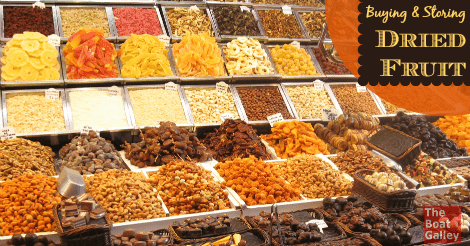Buying and storing commercially-packed dried fruit is pretty easy — you grab a package, pay for it and can store it almost anywhere on the boat and not have a problem. It won’t break, it can’t really crush and it’s got enough preservatives that it won’t get moldy. Simple.
And those bags of dried cranberries, bananas, apricots, dates and raisins are great on the boat, lasting virtually forever and adding a lot of variety to meals.
 But what if you buy dried fruit at a market, such as this one in Mazatlan? Ahhh, not so simple.
But what if you buy dried fruit at a market, such as this one in Mazatlan? Ahhh, not so simple.
At a market, the dried fruits are likely to be sold by someone who dried the fruit themselves — probably at home. And like anything else prepared at home, it has important differences from commercial dried fruit:
- No preservatives
- No standards of how it’s prepared
- No standards of how dry it is
- Inconsistent packaging
Now all that doesn’t mean that you shouldn’t buy it. Not by any means. We’ve had wonderful dried fruit in the US and many other countries in Central America, South America and even Africa.
But it takes a bit more effort on your part, both in buying and in storing it. And don’t expect it to last nearly as long (maybe it will, but don’t expect it). A few tips:
- Don’t buy from the first vendor you spot. Check out several before deciding which one to buy from.
- Buy the driest fruit — it is less likely to mold.
- There should not be any obvious blemishes or — heaven forbid — mold already growing.
- Ask to taste a piece if possible.
- Don’t buy more than you can eat in a month — it’s very doubtful that it will last longer than that.
- Inspect it carefully for bugs and/or dirt. Often fruit is dried outside on screens. Don’t buy anything that appears to have bugs in it, as they will quickly spread throughout the boat.
- Anything that is stored in bulk — such as in a barrel or large bucket — is more likely to have bugs in it than small, sealed packages.
When storing it, keep the following in mind:
- Should it have bugs or develop mold, you don’t want to contaminate anything else. It depends on how it was packaged when sold, but I usually put each package in a small Ziploc, seal it tightly, then put all of the same fruit into a large Ziploc or a sealed plastic container (don’t put it in something that doesn’t seal very tightly).
- Keep the packages in a cool, dry place. If you don’t really have a “cool, dry place” try to find somewhere that is a fairly constant temperature. Temperature swings cause condensation to build up in plastic bags, and once there is condensation, mold will quickly follow.
- It’s tempting to put the stuff you just bought on top of the older stuff, and then you eat the new stuff first and the older food just gets older . . . until it’s no good and wasted. Always put the new stuff under — or behind — the older.
- Always keep an eye out for bugs and mold and get rid of anything with even a tiny bit of either if you don’t want the problem to spread!
Do you have any other tips? Add them in the comments!

Carolyn Shearlock has lived aboard full-time for 17 years, splitting her time between a Tayana 37 monohull and a Gemini 105 catamaran. She’s cruised over 14,000 miles, from Pacific Mexico and Central America to Florida and the Bahamas, gaining firsthand experience with the joys and challenges of life on the water.
Through The Boat Galley, Carolyn has helped thousands of people explore, prepare for, and enjoy life afloat. She shares her expertise as an instructor at Cruisers University, in leading boating publications, and through her bestselling book, The Boat Galley Cookbook. She is passionate about helping others embark on their liveaboard journey—making life on the water simpler, safer, and more enjoyable.
Simplify meal prep on board with proven strategies for provisioning, maximizing fridge space, and cooking delicious meals aboard your boat.









Alex says
I wonder if it would be helpful (or possible) to dry a bit more back at the boat and kill any mold starting? If hot and sunny, spread out and let them finish off and make sure no extra moisture? Or put in a 150 degree oven for 15 minutes? I have made jerky, and some recipes recommend after the longer lower temp drying, to heat up to 150 to kill any remaining bacteria. The cooking is minimal at the lower temp, but it kills the bugs.
Eva Persson says
Very often they are coated with lots of sugar though, and then it is not healthy anymore. I have just found a store that had dried fruits without the added sugar. They look completely different, and they taste FRUIT!
Dave Skolnick (S/V Auspicious) says
Drying your own fruits etc. is not difficult and there ARE standards. See NCHFP https://nchfp.uga.edu/how/dry.html . We do have a vertical dehydrator at home, but maintaining 140F in a boat oven is not particularly hard. It does warm up the boat a bit so geography matters.
Some things are easier than others. Bananas, apricots, apples, and dates are easy. We’ve found buying raisins instead of drying grapes to be cheaper. Tomatoes work well but be prepared for more cleanup. Fresh herbs are a natural for drying. See the link. Mango is very nice. Bell peppers work pretty well in larger pieces.
We use quarter sheet pans with fitted racks for this task, cookware we use for sheet pan dinners, roasting pans, and baking sheets.